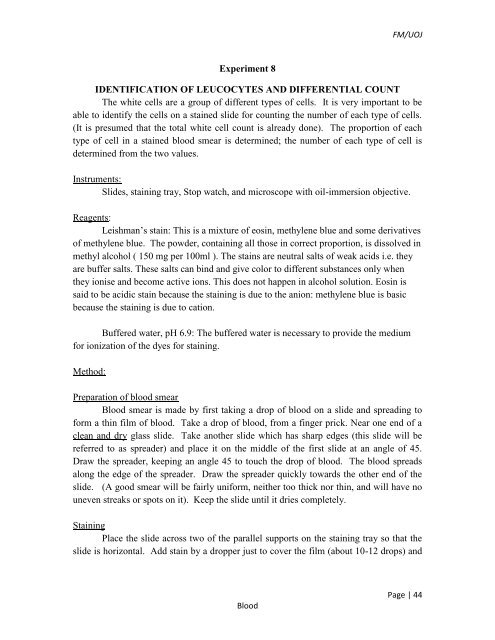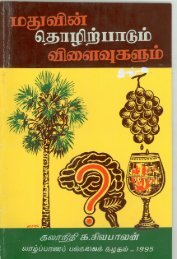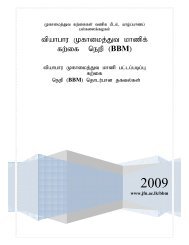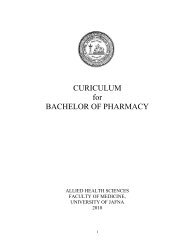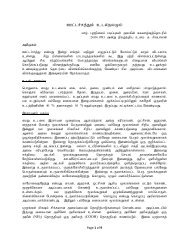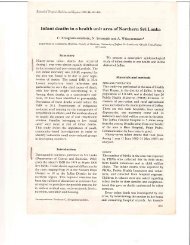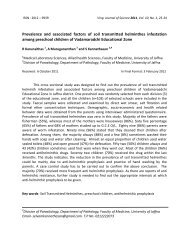MANUAL PHYSIOLOGY PRACTICAL - Repository:The Medical ...
MANUAL PHYSIOLOGY PRACTICAL - Repository:The Medical ...
MANUAL PHYSIOLOGY PRACTICAL - Repository:The Medical ...
You also want an ePaper? Increase the reach of your titles
YUMPU automatically turns print PDFs into web optimized ePapers that Google loves.
FM/UOJ<br />
Experiment 8<br />
IDENTIFICATION OF LEUCOCYTES AND DIFFERENTIAL COUNT<br />
<strong>The</strong> white cells are a group of different types of cells. It is very important to be<br />
able to identify the cells on a stained slide for counting the number of each type of cells.<br />
(It is presumed that the total white cell count is already done). <strong>The</strong> proportion of each<br />
type of cell in a stained blood smear is determined; the number of each type of cell is<br />
determined from the two values.<br />
Instruments:<br />
Slides, staining tray, Stop watch, and microscope with oil-immersion objective.<br />
Reagents:<br />
Leishman’s stain: This is a mixture of eosin, methylene blue and some derivatives<br />
of methylene blue. <strong>The</strong> powder, containing all those in correct proportion, is dissolved in<br />
methyl alcohol ( 150 mg per 100ml ). <strong>The</strong> stains are neutral salts of weak acids i.e. they<br />
are buffer salts. <strong>The</strong>se salts can bind and give color to different substances only when<br />
they ionise and become active ions. This does not happen in alcohol solution. Eosin is<br />
said to be acidic stain because the staining is due to the anion: methylene blue is basic<br />
because the staining is due to cation.<br />
Buffered water, pH 6.9: <strong>The</strong> buffered water is necessary to provide the medium<br />
for ionization of the dyes for staining.<br />
Method:<br />
Preparation of blood smear<br />
Blood smear is made by first taking a drop of blood on a slide and spreading to<br />
form a thin film of blood. Take a drop of blood, from a finger prick. Near one end of a<br />
clean and dry glass slide. Take another slide which has sharp edges (this slide will be<br />
referred to as spreader) and place it on the middle of the first slide at an angle of 45.<br />
Draw the spreader, keeping an angle 45 to touch the drop of blood. <strong>The</strong> blood spreads<br />
along the edge of the spreader. Draw the spreader quickly towards the other end of the<br />
slide. (A good smear will be fairly uniform, neither too thick nor thin, and will have no<br />
uneven streaks or spots on it). Keep the slide until it dries completely.<br />
Staining<br />
Place the slide across two of the parallel supports on the staining tray so that the<br />
slide is horizontal. Add stain by a dropper just to cover the film (about 10-12 drops) and<br />
Blood<br />
Page | 44


